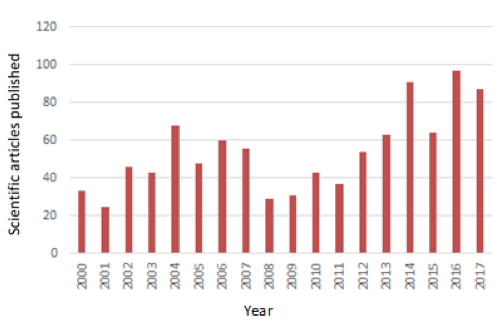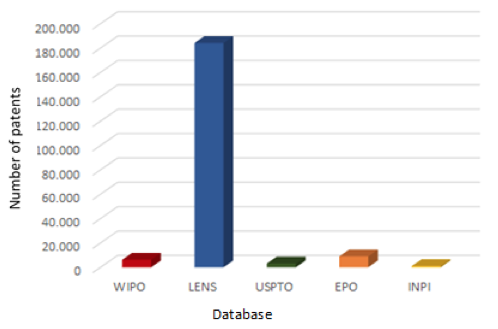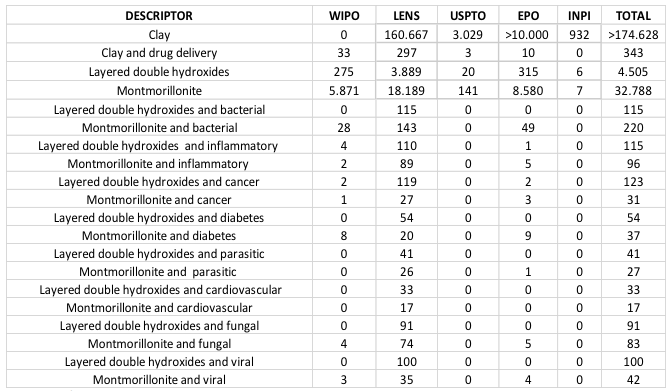

Vol. 39 (Number 13) Year 2018 • Page 27
Tamires Andrade da SILVA 1; Giselle Alves da PAIXÃO 2; Julio Henrique Rodrigues GOMES 3; José Wilson Curcino dos SANTOS 4; Irinaldo Diniz Basílio JÚNIOR 5; Ticiano Gomes do NASCIMENTO 6 ; Luciano Aparecido Meireles GRILLO 7; Camila Braga DORNELAS 8
Received: 24/11/2017 • Approved: 15/12/2017
ABSTRACT: Clays have been shown to provide promising alternatives to conventional drug delivery systems for the treatment of diseases. This work was intended as a technological survey, to present a general overview of the use of nanomaterials in the treatment of disease. The number of scientific papers (335,415) and patents (213,489) reflects the enormous potential of nanomaterials. The US has published the greatest number of articles on the subject, confirming its substantial technological prowess and interest in this area of research. |
RESUMO: As argilas têm se mostrado promissoras para serem utilizadas como alternativas no tratamento de doenças. Este trabalho teve como objetivo realizar uma prospecção tecnológica, apresentando o panorama geral das principais doenças que estão sendo investigadas frente a estes nanomateriais. O número de artigos científicos (335.415) e patentes (213.489) refletem sua enorme potencialidade. Como destaque tem-se o Estados Unidos como país que mais publicou sobre o tema, ratificando seu grande poder tecnológico e interesse em pesquisas nessa área. |
Nanotechnology is a broad area of research that is gaining increasing attention from investigators because of the diversity of applications in various fields of study (DI SIA, 2017). The emergence of nanomedicine, specifically the use of nanocarriers for drug delivery, has been the subject of much investigation in the diagnosis and treatment of various diseases (BOISSEAU and LOUBATON, 2011).
In pharmaceutical research, biocompatible nanocarriers have been designed for targeted delivery of drugs (KUMAR et al., 2017). Such transporters overcome the limitations of conventional drugs, including limited efficacy, poor distribution, and high incidence of adverse effects (KUMAR et al., 2007).
Nanotechnology has been deployed in the delivery of medicines for treatment of several diseases, including bacterial infections (GAO et al., 2017), cardiovascular diseases (KHAN et al., 2010), diabetes (LIN et al., 2017), and cancer (DINESH et al., 2016).
In this context, the use of lamellar clays, a natural source of nanomaterials, has stood out, owing to their numerous applications (DORNELAS et al., 2010; RIVES et al., 2014). Depending on their particular structural characteristics, lamellar clays can be classified as either cationic or anionic (COELHO and SANTOS, 2007).
Cationic clays, such as montmorillonite (MMT), consist very fine particles with high surface charge and large surface area. They swell in the presence of water, and permit cation occupation in interlamellar surfaces (DORNELAS et al., 2010).
Lamellar double hydroxides (LDHs) are representative of the anionic clays. These have a positive residual charge, and to compensate for this charge, it is necessary to have anions, which, together with water, promote lamellar stacking (BENÍCIO et al., 2015).
All lamellar clays have ion exchange capacity, to greater or lesser degrees, depending on the characteristics of the particular clay. It is on the basis of this property that compound intercalations are generated (COELHO and SANTOS, 2007). Two-dimensional host matrices may be used, in which empty sites lie between the lamellae. Taking into account their particular structure, many drugs can be intercalated in one of these clays (YANG et al., 2016).
Lamellar clays may be thought of as nanodevices that improve drug bioavailability. Through the vectorization of active compounds, lamellar clays permit controlled release, and, as a consequence, fewer adverse effects (CUNHA et al., 2010; YANG et al., 2016). They may also increase drug solubilization rates (PERIOLI et al., 2011).
Many drugs have been successfully intercalated in lamellar double hydroxides and montmorillonite, including antibiotics (WANG and ZHANG, 2012; CALABRESE et al., 2013), chemotherapeutic agents (PANG et al., 2013; ILIESCU et al., 2014), and anti-inflammatories (SAN ROMÁN et al., 2012; KAUR and DATTA, 2014), among others (RIVES et al., 2014).
This work aimed to survey published articles and deposited patents in Brazil and the rest of the world, specifically relating to the combinastion of drugs with various therapeutic classes of lamellar clays, and to provide an overview of the current state of scientific development in the use of these nanomaterials.
The survey used patent data deposited in the World Intellectual Property Organization (WIPO), Patent Lens (LENS), the United States Patent and Trademark Office (USPTO), the European Patent Office (EPO) and the database of the National Institute of Industrial Property (INPI) in Brazil. The systematic review consisted of analyzing the SCIENCE DIRECT, PUBMED, WEB OF SCIENCE, SCOPUS, and SCIELO databases.
This survey was conducted in November 2017, and included all available years in the databases, selecting for keywords included in the title and/or abstract. Initially, the keyword "Clays" was used. Shortly thereafter, we used "Clays and drug delivery". Then, the carriers under discussion: "Layered double hydroxides" and "montmorillonite" were combined with search terms for various diseases, as follows: a) Bacterial, b) Inflammatory, c) Cancer, d) Diabetes, e) Parasitic, f) Cardiovascular, g) Fungal, and h) Viral.
Table 1 displays the protocol for all descriptors in the searched databases. We found a total of 335,415 articles. The database with the highest number of articles was Scopus (179,660). The most common clay used in investigation of disease treatments was montmorillonite, with a total of 934 published works. Lamellar double hydroxides had 414.
The therapeutic class that most yielded publications for the two clays were chemotherapeutic agents (287), followed by antibiotics (731) and anti-inflammatories (159). Zhang et al. (2014) prepared intercalated methotrexate, and bioassays suggested the preparation effectively suppressed tumor cells. Wang and Zhang, (2012) intercalated four antibiotics (benzoate, chloramphenicol, benzylpenicillin and ticarcillin) in LDHs, and all were efficient in assays of antibacterial activity and controlled release.
Table 1
Search results for scientific articles in databases according to the descriptors below

Source: compiled by the authors (2017)
San Román et al. (2012) evaluated the intercalation of diclofenac, ketoprofen, and chloramphenicol. Their findings differed from other studies that had already reported the intercalation of these drugs (TAMMARO et al., 2007; AMBROGI et al., 2008). The differences may be due to the fact that they used two bivalent cations, Mg and Zn, and a trivalent cation, Al, to compose the LDH lamellas. They aimed to achieve a more pure, crystalline system. Via this technique they were able to obtaining well-crystallized solids, and to verify the presence of anions between the lamellae of the clay. The importance of this system was that it increased the solubility of these drugs and diminished their adverse effects (AMBROGI et al., 2003).
Drugs from the following three classes were also associated with montmorillonite: 5-fluorouracil (5-FU) (KEVADIYA et al., 2012), metronidazole (KEVADIYA et al., 2013) and diclofenac (KAUR and DATTA, 2014).
There were few studies related to parasitic diseases (1) and diabetes (6), although these too require effective drugs with fewer complications than current therapies (SILVA et al., 2017; GOURGARI et al., 2017).
Figure 1 illustrates the progress in the publication of scientific articles specifying the descriptor "clay and drug delivery" in all searched databases. As stated above, the years with the greatest number of publications were 2014 (97) and 2016 (91). To date, 87 articles have been published, demonstrating the growing interest in the use of clays for drug delivery, in light of the countless limitations of current drug delivery systems (NEVOZHAY et al., 2007).
Figure 1
Progressive increase in the number of articles published 2000-2017.

Source: compiled by the authors (2017)
In Figure 2, we show a map of published or successful patent applications. Among all the databases investigated, the database that presented the largest number of patent documents was LENS, with 91% of the total patents analyzed.
Figure 2
Distribution of patents by database

Source: compiled by the authors (2017)
Table 2 displays the general overview of the survey performed on all patent databases with all the descriptors investigated. Bacterial disease (220), inflammatory diseases (211), and cancer (154), returned the highest number of records in all patent databases, results similar to those found in the literature databases.
Table 2
Search results for patents in databases according to the descriptors below

Legend: ¹World Intellectual Property Organization, 2 Patent Lens,
3 United States Patent and Trademark Office (USPTO), 4 European Patent Office (EPO) e
5 Instituto Nacional de Propriedade Industrial. Source: compiled by the authors (2017)
Figure 3 shows the percentage and progression of the number of patent applications in recent years with the descriptor "Clay and drug delivery" in all databases investigated. The highest number of patents registered was in 2014 (29), reflecting substantial progress in the field of nanotechnology (ROSSI-BERGMANN, 2008).
Figure 3
Progress in patent registration 2000-2017.

Source: compiled by the authors (2017)
We found no patent documents in INPI related to clays and disease treatment, despite the promise shown by early results, and the extensive research already conducted in the scientific community (RIVES et al., 2014), evidenced by the total number of relevant articles published (1,348).
We identified eight countries with the most patents applications according to all databases with the descriptor "Clay and drug delivery" (Figure 4). The US was responsible for the majority of nanomedicine patents, accounting for more than 89% of the total, substantially more than any other country.
Figure 4
Patent depository by country.

Source: compiled by the authors (2017)
Figure 5 shows the international classification of patents according to LENS. Note that the class with the largest number of records (98) was A61: "PREPARATIONS FOR MEDICAL, DENTAL OR HYGIENIC PURPOSES", followed by A61Q (86): "SPECIFIC USE OF COSMETICS OR SIMILAR PREPARATIONS FOR PERSONAL HYGIENE".
Figure 5
Number of patents deposited according to the Cooperative
Patent Classification (CPC) in the LENS database.

Source: compiled by the authors (2017)
Nanomaterials show promise for many applications in medicine. This technological survey reflects the scientific and technological progress in the use of clays for drug delivery. Nanotechnological research should be encouraged, given the appearance of increasing numbers of nanomedicines with good efficacy and few adverse effects. Our survey obtained 335,415 articles and 213,489 patents. The databases that returned the greatest number of hits were SCOPUS and LENS, respectively. The most investigated diseases were cardiovascular, bacterial, and inflammatory. The exponential increase in recent years of articles and patents demonstrates how promising these nanomaterials have become.
We are grateful to the funding bodies, the Foundation for Research Support of the State of Alagoas (FAPEAL) and Coordination for the Improvement of Higher Education Personnel (CAPES) for all their support.
Ambrogi, V., Fardella, G., Grandolini, G., & Nochetti, M. (2003). Effect of hydrotalcite-like compounds on the aqueous solubility of some poorly water-soluble drugs. Journal of Pharmaceutical Sciences, 92, pp. 1407–1418.
Ambrogi, V., Perioli, L., Ricci, M., Pulcini, L., Nocchetti, M., Giovagnoli, S., & Rossi, C. (2008). Eudragit® and hydrotalcite-like anionic clay composite system for diclofenac colonic delivery. Microporous and Mesoporous Materials, 115, pp. 405–415.
Benício, L., Silva, R., J.A., L., Eulálio, D., Santos, R., Aquino, L., . . . Tronto, J. (2015). Layered Double Hydroxides: nanomaterials for applications in agriculture. Revista Brasileira de Ciência do Solo, 39(1), pp. 1-13.
Boisseau, P., & Loubaton, B. (2011). Nanomedicine, nanotechnology in medicine. Dans L. Laurent, & J. Villain, Comptes Rendus Physique - Nanoscience and nanotechnologies: hopes and concerns (pp. 620-636). Académie des Sciences.
Calabrese, I., Cavallaro, G., Scialabba, C., Licciardi, M., Merli, M., Sciascia, L., & Turco Liveri, M. (2013). Montmorillonite nanodevices for the colon metronidazole delivery. International Journal of Pharmaceutics, 457, pp. 224–236.
Coelho, A., & Santos, P. (2007). Argilas especiais: argilas quimicamente modificadas- uma revisão. Química Nova, 30(5), pp. 1282-1294.
Cunha, V. (2010). Hidróxidos Duplos Lamelares: nanopartículas inorgânicas para armazenamento e liberação de espécies de interesse biológico e terapêutico. Química Nova, 33(1), pp. 159-171.
Di Sia, P. (2017). Nanotechnology Among Innovation, Health and Risks. Procedia- Social and Behavioral Sciences, 237, pp. 1076-1080.
Dinesh, B., Biancoa, A., & Ménard-Moyon, C. (2016). Designing multimodal carbon nanotubes by covalent multi-functionalization. Nanoscale, 8(44), pp. 18596 - 18611.
Dornelas, C., Grillo, L. M., Basílio- Junior, I., Nascimento, T., Resende, D., Tavares, M., . . .Cabral, L. (2010). Estudo do processo de intercalação via solução PVP-bentonita: a avaliação da influência do tempo reacional, da proporção de polímero-argila e da massa molar média. Polímeros, 20(4), pp. 275-279.
Gao, W., Chen, Y., Zhang, Y., Zhang, Q., & Zhang, L. (2017). Nanoparticle-based local antimicrobial drug delivery. Advanced Drug Delivery Reviews, pp. 1-37.
Gourgari, E., Wilhelm, E., Hassanzadeh, H., Aroda, V., & Shoulson, I. (2017). A comprehensive review of the FDA-approved labels of diabetes drugs: Indications, safety, and emerging cardiovascular safety data. Journal of Diabetes and its Complications, 31(12), pp. 1719-1727.
Iliescu, R., Andronescu, E., Ghitulica, C., Voicu, G., Ficai, A., & Hoteteu, M. (2014). Montmorillonite-alginate nanocomposite as a drug delivery system--incorporation and in vitro release of irinotecan. International Journal of Pharmaceutics, 463(2), pp. 184-192.
Kaur, M., & Datta, M. (2014). Diclofenac sodium adsorption onto montmorillonite: adsorption equilibrium studies and drug release kinetics. Adsorption Science & Technology, 32, pp. 365-387.
Kevadiya, B., Patel, T., Jhala, D., Thumbar, R., Brahmbhatt, H., Pandya, M., . . . H.C., B. (2012). Layered inorganic nanocomposites: a promising carrier for 5-fluorouracil (5-FU). European Journal of Pharmaceutics and Biopharmaceutics, 81, pp. 91-101.
Kevadiya, B., Thumbar, R., Rajput, M., Rajkumar, S., Brambhatt, H., Joshi, G., . . . Bajaj, H. (2013). Montmorillonite/poly-(epsilon-caprolactone) composites as versatile layered material: reservoirs for anticancer drug and controlled release property. European Journal of Pharmaceutics and Biopharmaceutics, 47, pp. 265–272.
Khan, T., Vohra, R., & Homer-Vanniasinkam, S. (2010). Nanotechnology and nanomedicine in cardiovascular therapy. In T. Gourlay, & R. Black, Biomaterials and Devices for the Circulatory System (pp. 251-269). Cambridge: Woodhead Publishing.
Kumar, B., Jalodia, K., Kumar, P., & Gautam, H. K. (2017). Recent advances in nanoparticle-mediated drug delivery. Journal of Drug Delivery Science and Technology, 41, pp. 260-268.
Lin, C.-H., Chen, C.-H., Lin, Z.-C., & Fang, J.-Y. (2017). Recent advances in oral delivery of drugs and bioactive natural products using solid lipid nanoparticles as the carriers. Journal of Food and Drug Analysis, 25(2), pp. 219-234.
Nevozhay, D., Kanska, U., Budzynska, R., & J.Boratynski. (2007). Current status of research on conjugates and related drug delivery systems in the treatment of cancer and other diseases. Postepy Higieny I Medycyny Doswiadczalnej, 61, pp. 350-360.
Pang, X., Ma, X., Li, D., & Hou, W. (2013). Synthesis and characterization of 10- hydroxycamptothecin – sebacate – layered double hydroxide nanocomposites. Solid State Sciences, 16, pp. 71-75.
Perioli, L., Ambrogi, V., Di Nauta, L., Nocchetti, M., & Rossi, C. (2011). Effects of hydrotalcite-like nanostructured compounds on biopharmaceutical properties and release of BCS class II drugs: the case of flurbiprofen. Applied Clay Science, 51, pp. 407–413.
Ravi Kumar, M. (2000). Nano and microparticles as controlled drug delivery devices. Journal of Pharmacy and Pharmaceutical Sciences, 3(2), pp. 234-258.
Rives, V., Arco, M. d., & Martín, C. (2014). Intercalation of drugs in layered double hydroxides and their controlled release: A review. Applied Clay Science, 88-89, pp. 239-269.
Rossi-Bergmann, B. (2008). A nanotecnologia: da saúde para além do determinismo tecnológico. Ciência e Cultura, 60(2), pp. 54-57.
San Román, M., Holgado, M., Salinas, B., & Rives, V. (2012). Characterisation of Diclofenac, Ketoprofen or Chloramphenicol Succinate encapsulated in layered double hydroxides with the hydrotalcite-type structure. Applied Clay Science, 55, pp. 158-163.
Silva, T., Santos-Júnior, P., Rodrigues, É., Santos, L., Silva-Júnior, E., Santos, J., . . . Nascimento, T. (2017). Technological prospecting of leishmania associated with nanocarreadores and imidazol. Revista Espacios, 38(47), pp. 30-37.
Wang, Y., & Zhang, D. (2012). Synthesis, characterization, and controlled release antibacterial behaviour of antibiotic intercalated Mg–Al layered double hydroxides. Materials Research Bulletin, 47, pp. 3185–3194.
Yang, J.-H., Lee, J.-H., Ryu, H.-J., A.Elzatahryb, A., Alothman, Z. A., & Choy, J.-H. (2016). Drug–clay nanohybrids as sustained delivery systems. Applyed Clay Science, 130, pp. 20-32.
1. Doctoral student in the Post-Graduate Program in Health Sciences, Federal University of Alagoas - UFAL. Email: tamires_a@hotmail.com
2. Graduate of the Pharmacy Program at the Federal University of Alagoas. Email: giselle.alves16@gmail.com
3. Graduate of the Pharmacy Program at the Federal University of Alagoas. Email: juliohgomess@gmail.com
4. Graduate of the Chemical Engineering Program at the Federal University of Alagoas. Email: jwcs_@hotmail.com
5. Professor, Federal University of Alagoas - UFAL. Email: irinaldodiniz@yahoo.com.br
6. Professor, Federal University of Alagoas - UFAL. Email: ticianogn@yahoo.com.br
7. Professor, Federal University of Alagoas - UFAL. Email:lucianomeirelesgrillo@gmail.com
8. Professor, Federal University of Alagoas - UFAL. Email: dornelascb@yahoo.com.br